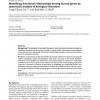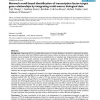39 search results - page 1 / 8 » Identifying functional relationships among human genes by sy... |
114
click to vote
BMCBI
2002
15 years 4 days ago
2002
Background: The availability of biomedical literature in electronic format has made it possible to implement automatic text processing methods to expose implicit relationships amo...
131
click to vote
BMCBI
2005
15 years 6 days ago
2005
Background: Protein kinases are a well defined family of proteins, characterized by the presence of a common kinase catalytic domain and playing a significant role in many importa...
119
click to vote
BMCBI
2008
15 years 13 days ago
2008
Background: Integrating data from multiple global assays and curated databases is essential to understand the spatiotemporal interactions within cells. Different experiments measu...
100
click to vote
BMCBI
2008
15 years 13 days ago
2008
Background: Eukaryotic cell cycle is a complex process and is precisely regulated at many levels. Many genes specific to the cell cycle are regulated transcriptionally and are exp...
BMCBI
2006
15 years 11 days ago
2006
Background: Quantitative simultaneous monitoring of the expression levels of thousands of genes under various experimental conditions is now possible using microarray experiments....


